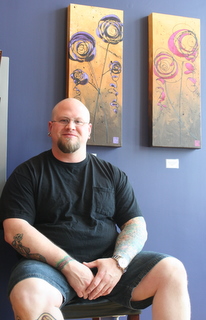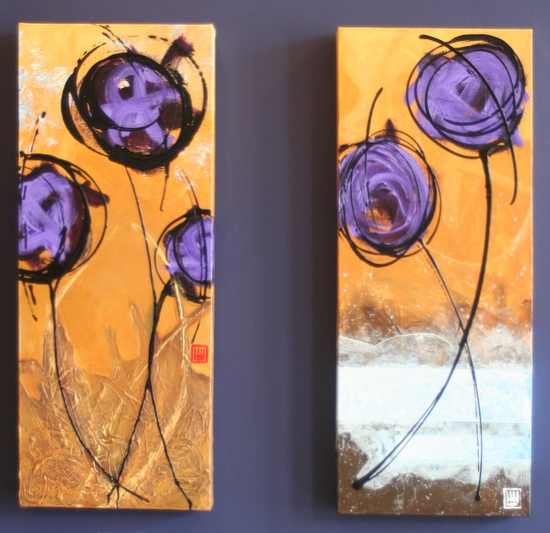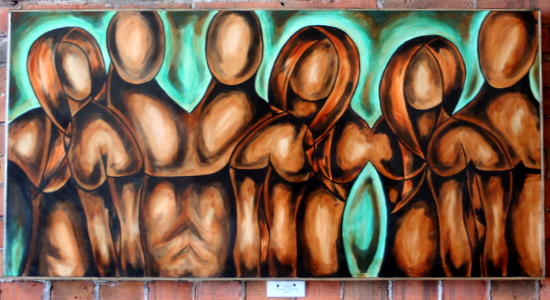 Some people would never walk into a tattoo shop. Others would never walk into an art gallery.
Some people would never walk into a tattoo shop. Others would never walk into an art gallery.
Mark Schwalm-Bell wants to draw both groups to Indigo Body Art Gallery, located just off the Centennial Bridge at 717 West Third Street in Davenport.
Schwalm-Bell argues that most tattoo businesses scare off a lot of people, and it's evident walking in to Indigo that its atmosphere is in direct opposition to the stereotypical tattoo parlor; the studio, which opened February 15, is tastefully appointed and offers plenty of breathing room in its 1,100 square feet.
The owner/tattoo artist said he wanted to create the vibe of "a comfortable coffeehouse, a spoken-word coffeehouse. I wanted it to be a little more urban, a little more bohemian, a little more educated, a little more art-centric ... ." The narrow but deep Indigo space is an excellent starting point, with a brick eastern wall and a high ceiling in a building that's nearly 120 years old.
But it's the "art-centric" aspect that really distinguishes Indigo from other tattoo studios: Its walls showcase paintings divorced from traditional tattoo style or subject matter. Indigo currently features the work of three artists, including St. Ambrose University student Meghan Hollister and Iowa City resident Jason "Ja" Strating. Schwalm-Bell charges artists neither commission nor wall rent.
"Our vision for the studio is that we want to have two separate but complementary lines of business ... : a fully functioning art gallery as well as a traditional body-art studio ... ," Schwalm-Bell said. "We want to try to distance ourselves from the traditional body-art community ... ."
Schwalm-Bell speaks too broadly and absolutely in denigrating tattoo-studio culture, and he can occasionally come off as boastful. (He claims that hospitals and dentists' offices "are less stringent about things [sterilization] than I am.") But there's no denying that Indigo is a departure from the norm.

Schwalm-Bell doesn't expect much crossover business; he doubts many tattoo customers will buy art, or that many art patrons will get inked. But he said he hopes that as "a rather unique crossing point between art and body art," Indigo will be a comfortable place for people leery of body-art studios or art galleries. He also called his business "a completely different spin on the second-oldest profession in the world." ("Any time they find a mummy with skin on it, it has tattoos," Schwalm-Bell noted. Tattoos have been found on a mummy more than 5,000 years old.)
Indigo features a bookcase with movies, including the expected zombie flicks but also movies appropriate for children, and most curious readers will find some book that piques their interest. (How many other tattoo studios have a copy of Little Women?)
Indigo also has a vintage card catalog from the University of Iowa. Schwalm-Bell anticipates that the piece will one day sit in his wife's office. "In the meantime," he said, "it's where I hide candy for my wife and for kids." Yes, Schwalm-Bell sees Indigo as a place where a parent can bring the kids while getting tattooed or pierced.

He has been tattooing for seven years, but it was not a career choice approved by his family, particularly his mother. He said he first wanted tattoos because of his Great Uncle Bob - a 20-year Navy man with three tattoos on each arm. "I just always thought they were the coolest things in the world," Schwalm-Bell said. "I knew I wanted to get a tattoo when I was four or five years old; I used to talk about it all the time."
That was no different from kids wanting to be a firefighter or a professional football player, but Schwalm-Bell said that his dream stuck with him: "I knew I wanted to be heavily tattooed from the time I was in high school."
But there was community pressure against it to go with the family opposition. He recalled that in 1991, the captain of his school's cheer squad got a tattoo, which spurred a discussion in his English class. "It was this whole scandalous thing," he said. Each student was asked what tattoo he or she would get, and Schwalm-Bell said he wanted sleeves. The school guidance counselor called his parents.
"Needless to say, when I turned 18, I didn't run out and get a tattoo," Schwalm-Bell said. But when he was a 22-year-old senior at Luther College, he got the tattoo he'd wanted since age six: the Incredible Hulk on his shoulder. "That went over really, really, really poorly at my house," he said.
It's taken a long time for his mother to come around, but Schwalm-Bell said she's now proud of him. And he argued that tattoos aren't much different from haircuts: "These are all ways that we change ourselves ... . Tattoos are a slightly more colorful and more permanent means to that end."
For more information on Indigo Body Art Gallery (including a tattoo portfolio), visit IndigoBodyArtGallery.com.
